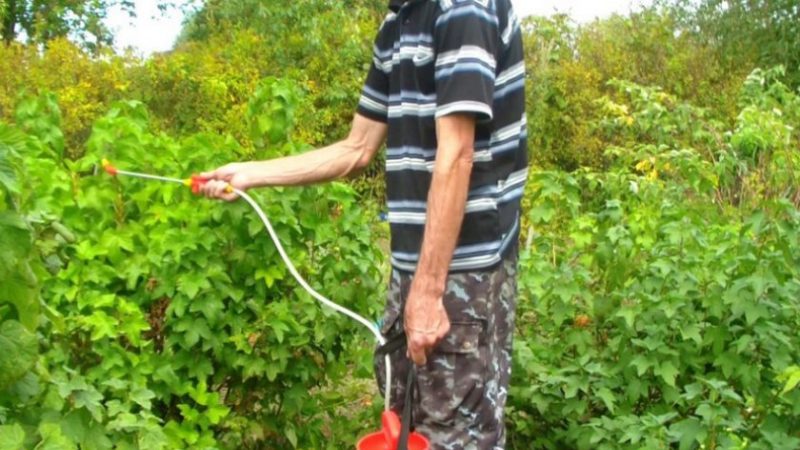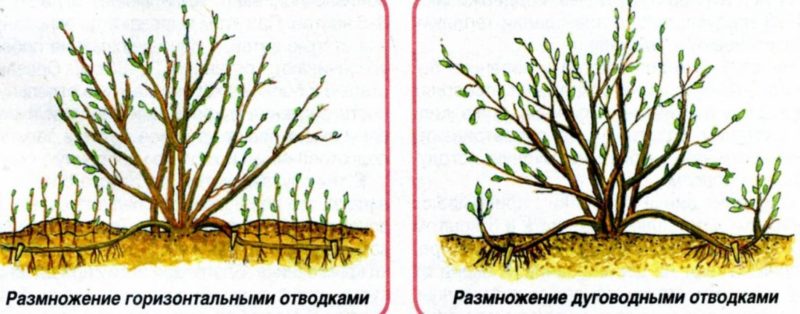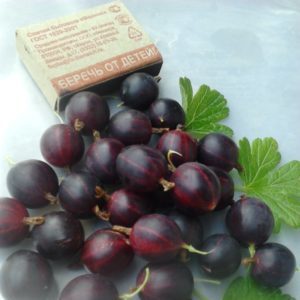What is the good gooseberry Commander (Vladil) and why it is worth growing
Gooseberry Commander is successfully grown in private and industrial farms. The main advantage of the variety is the absence of thorns on the shoots, which greatly facilitates harvesting and caring for the bushes. We will tell you in detail about the intricacies of growing the variety and its agrotechnical requirements that must be observed in order to obtain a high-quality harvest.
The content of the article
What is this gooseberry variety
Commander (Vladil) is a mid-early gooseberry variety. The berries ripen from late May to late June, the harvest is harvested from mid-July to late August. Average yield - 3.7-6.9 kg per bush.
Reference. In the case of a large harvest, the berries are formed small.
The fruits are harvested as they ripen, in dry and sunny weather. The crop is sorted out, all damaged berries are rejected and dried within 2-3 hours. At a temperature of + 18 ° C and an air humidity of 80%, the fruits of the Commander are stored for 4-5 days, at + 5 ... + 8 ° C - a week.
History of origin and distribution

Gooseberry Komandor was bred in 1995 at the South Ural Research Institute of Fruit and Potato Growing by Professor Vladimir Ilyin, in whose honor he received the second name Vladil.
The parent plants were African and Chelyabinsk green varieties, from which the Commander took the best qualities.
The variety was entered into the State Register of Russia in 1995 and approved for cultivation in the North-West, Volgo-Vyatka, Middle Volga, Ural and West Siberian regions.
Characteristics and description of the bushes
The bushes are strong or medium-sized (up to 1.5 m), slightly spreading, dense. Shoots are thin (2-5 cm in diameter), straight, hairless, almost without thorns, green-brown. Places that are under the sun for a long time acquire a pinkish tint.
The buds are oval in shape with a pointed tip. Leaves 3- or 5-lobed, with a convex base, large or medium-sized, glossy, green, with blunt and short denticles at the edges. They are located alternately on light green or yellowish slightly pubescent petioles of medium length.
Flowers are small, yellow-green, cupped, collected in inflorescences of 2-3 pcs.
Resistant to temperatures
It is a frost-resistant variety. It tolerates a drop in air temperature to -25 ... -35 ° C, but in conditions of little snowy winters it needs additional shelter.
Moisture and drought resistance
The bushes can withstand short-term drought. Prolonged (more than 10 days) lack of moisture has a negative impact on the development and fruiting of plants.
Disease and pest resistance
The variety is resistant to powdery mildew, late blight, anthracnose, moths and sawflies. It can be affected by rust, shrinking stems, white spot, gray mold, mosaic disease, gall midges, aphids, moths, spiderweb and currant bud mites, and currant glass.
Characteristics and description of fruits
The berries weigh an average of 5.6-7 g, are covered with a smooth, thin and delicate skin of a burgundy brown color.
The pulp is dark raspberry, juicy, with a small amount of black seeds, characterized by a sweet taste with a slight acidity.
Application area
Vladil's berries are consumed fresh, used to make jams, jams and compotes, frozen and ground with sugar.
Advantages and disadvantages of the variety

Vladil's advantages:
- stable high yield;
- thornless shoots;
- resistance to a number of diseases and pests characteristic of the culture;
- drought and frost resistance;
- lack of tendency to crack fruit;
- the possibility of universal use of berries.
Cons of the variety:
- poor transportability;
- short shelf life of fresh berries.
Growing technology
In order for the bushes to develop well and bear fruit, it is important to plant the seedlings correctly and in a timely manner, choose the most suitable place on the site and comply with the agrotechnical requirements of the variety.
Optimal conditions
When buying planting material, the choice is made on 1- or 2-year-old seedlings.
Instances with an open root system should have:
- 2-3 strong growths with a maximum height of 25 cm;
- dormant axillary buds;
- trunks of uniform gray color;
- developed, lignified and not overdried rhizome about 25 cm long, consisting of several core and many additional processes.
There should be no leaves.
Reference. Seedlings with an open root system are purchased a maximum of 3 days before planting.
Plants with closed roots should have 2-3 strong growths 30 cm high (for 1-year-old seedlings) or 40-50 cm (for 2-year-old specimens) and leafy shoots.
24 hours before planting, the seedlings are examined, all dry and damaged areas are removed, the shoots are cut to 3 buds, the rhizome is soaked for 12 hours in a growth stimulator solution (Kornevin, Heteroauxin) with the addition of potassium permanganate.
For planting, a well-lit place, protected from cold gusty winds, with a groundwater depth of 1.5-2 m, is chosen.
Lack of light causes a decrease in yield, and waterlogging of the soil causes rotting of the roots.
The crop prefers loose, light, fertile soil with good air and moisture permeability and low or neutral acidity.
Six months before planting, the site is cleaned of plant residues, dug to a depth of 40 cm, spilled with a solution of copper sulfate (300 g of substance per 10 liters of water) at the rate of 1 liter per 10 sq. m for disinfection and for every 1 sq. m 10 kg of humus, peat or manure and 100 g of superphosphate are introduced. Dolomite flour or lime is additionally added to acidic soil.
Terms and rules of landing
For the Commander, spring (March, before the start of sap flow) and autumn (until mid-October) planting is permissible. In spring, gooseberries are planted everywhere, in autumn - only in the southern regions.
Landing rules:
- In the selected area, prepare rows at a distance of 1.5 m from each other.
- Every 1-1.2 m, dig planting holes in them with a size of 65 × 55 cm.
- Fill each third with a nutritious soil mixture (half of the excavated soil, 10 kg of humus or rotted manure, 250 g of wood ash, 300 g of powdered lime and 30 g of urea in case of spring planting.
- Pour 10 liters of water into the pits and leave for 3-4 hours.
- Place the seedling in the center of the hole at an angle of 45 ° and straighten its roots.
- Fill the voids with earth so that the root collar is 5 cm deep.
- Water the planting at the rate of 5-10 liters of water for each bush.
After the soil has dried out, the trunk circle is mulched with compost mixed with the remnants of a nutrient mixture in a 1: 1 ratio.
Further care

The frequency of watering depends on the weather: in the heat, the bushes are watered every 2 days, in the cool period - weekly at the rate of 3-5 liters of water for each plant. 2 weeks before harvesting, watering is reduced so that the skin of the berries does not become sour.
After watering or rain, the soil is loosened to a depth of 5 cm and cleaned of weeds. To retain moisture, the soil is mulched with hay or compost.
Fertilizers introduced from 2 years after planting gooseberries according to the scheme:
- end of April - dung infusion (1 liter of liquid mullein or 300 g of chicken droppings per 10 liters of water);
- autumn, 20 days before frost - 100 g of superphosphate and 20 g of potassium salt per 1 sq. m of the trunk circle.
Formation of bushes train for the first 3-4 years. Before planting, the shoots are shortened, and by the next season 4-6 new growths up to 40 cm in length are formed on them. Of these, 3-4 developed shoots are chosen and shortened by a third, and the rest are completely cut off.
For 2-3 years after planting, root shoots are removed, leaving 3-5 branches, and on 1-year-old shoots, 2 strong growths are left. Starting from the 4th year of the life of the bushes, pruning consists in removing branches that thicken the crown and compete with the skeletal ones.
For bushes aged 6 years and older, rejuvenating pruning is carried out, annually completely cutting off 3 shoots, which bear little fruit and give an increase of less than 30 cm per year.
Reference. To prevent Vladil's branches from breaking under the weight of the crop, special supports installed at the beginning and end of the row are used.
Possible problems, diseases, pests

Diseases and pests that can infect the commander's bushes:
| Disease / pest | Signs | Treatment / prevention |
|---|---|---|
| Rust | Orange, brick or copper bumps appear on the berries and the inside of the leaves. | Before flowering and after harvest, the plants are sprayed with copper oxychloride. |
| Shrinking stems | Cracks with fungal spores appear on the bark. | Dry stems are pruned, all cracks process bordeaux liquid. |
| White spot | Light gray spots appear on the leaves. | Leaves and soil are sprayed with Bordeaux liquid, "Nitrofen", or copper sulfate. For prevention, the procedure is repeated after harvest and before flowering. |
| Mosaic disease | Foliage wilting and dropping, the appearance of light green or yellow stripes, circles and spots along the inner veins of the leaves. | There is no cure. Infected plants are dug up and burned, the site is planted with green manure. |
| Gray rot | Fall and decay of fruits, leaves and shoots. | The affected parts of the plants are cut off, the bushes are treated with Fitosporin. |
| Moth | Caterpillars of gray color that feed on leaves. | Pests are harvested by hand, the soil is spilled with boiling water in spring, the bushes are sprayed with chamomile infusion, "Commander", "Aktellik", "Kinmiks" or "Iskra". |
| Currant gall midge (shoot and leaf) | Small brown insects feed on leaf sap and wood, causing the shoots to dry out and break. | Before flowering and after harvesting the fruits, the bushes are treated with "Fufanon" or "Karbofos", for the prevention of plants they are sprayed with infusion of wormwood, mustard powder, and tomato tops. |
| Currant glass | These are caterpillars that live in cracks in the bark and eat wood from the inside. | The ground under the bushes is loosened to a depth of 10 cm and wood ash, mustard powder, ground red pepper and tobacco dust are scattered there. |
| Aphid | Small insects settle on the inside of the leaf plates and suck the juice from the leaves. | The leaves are sprayed with a solution of laundry soap, infusion of hot pepper, preparations "Aktara", "Karbofos", "Aktellik". |
| Currant kidney mite | The insect settles in flower and leaf buds and eats them out from the inside. | The bushes are sprayed with a solution of colloidal sulfur. |
| Spider mite | Pests settle on the lower part of the leaves, suck the juices out of them and entangle them with white cobwebs. | The plantings are sprayed with "Commander", infusion of wormwood or potato tops, treated with acaricides "Bankol", "Apollo" or "Sunmight". |
Wintering
2.5-3 weeks before frost, bushes and soil process copper sulfate, and 4 days after that, water-charging irrigation is carried out, pouring 20-30 liters of water under each bush.
A day later plants feed superphosphate and potassium salt, the trunk circle is mulched with peat or straw.
In the case of winters with little snow, the branches are bent to the ground, fixed with metal brackets and covered with agrofibre.
Features of cultivation depending on the region
The Commander's care requirements do not change depending on the climate of the region. The only difference is in timing landing: planting bushes in the fall is permissible only in the southern regions.
Pollinating varieties
Komandor is a self-pollinated crop that does not need pollinating varieties. However, the yield is improved when several bushes of this variety are planted in the same area.
Reproduction

The most convenient way to reproduce the Commander is by layering. To do this, in September - October, zero one-year-old growths are chosen on 6-year-old bushes, they are bent to the ground, fixed with brackets, sprinkled with a layer of soil 10 cm high, watered, mulched with sawdust and looked after like an adult plant.
In the fall, when the layers sprout and take root, they are separated from the parent plant, dug up and divided into parts according to the number of shoots. Each part is planted in an individual peat container filled with a mixture of equal parts of sand, peat, compost and garden soil. In the spring, seedlings are planted in a permanent place.
Vladil is also propagated by cuttings and dividing the bush.
Reviews of summer residents

Gardeners speak positively about the variety.
Inga, Nizhny Novgorod: "This is a very decent variety. We have 5 varieties of gooseberries growing on our site, but first of all we eat the Commander. Its berries, although small, are very tasty, and they are easy to pick, because there are no thorns on the shoots. "
Vera, Voronezh: “At first, the variety did not impress me, for 4 years it did not bear fruit at all, and I was already thinking about getting rid of the bushes. But then he sharply went into growth and began to produce crops. There are a lot of berries, we don't have time to eat them, so I make jam and compotes out of them. "
Conclusion
Commander, or Vladil, is a mid-early gooseberry variety, among the indisputable advantages of which are the spinelessness of the shoots, stable yield, frost resistance, the ability to tolerate short-term drought and immunity to a number of diseases and pests. The disadvantages of the variety include a short shelf life of fruits and poor transportability.